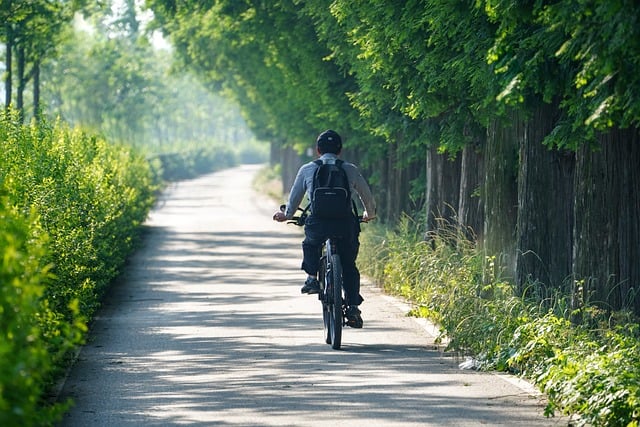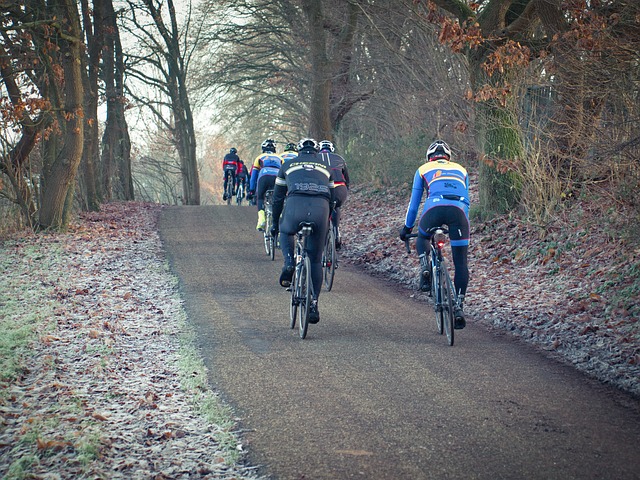When cycling at night, prioritize a high-lumen flashlight with a minimum of 200 lumens for city paths, with options ranging from 400 to 800 lumens for busier or dimly lit areas. Ensure your flashlight is durable, water-resistant, and has long-lasting batteries or rechargeable capabilities for extended use. Adjustable beam settings are beneficial for various conditions, with a focus on a spotlight for distant threats and a floodlight for improved peripheral vision. Reflective gear and additional lighting accessories like headlamps and flashing rear lights will further enhance your visibility. Flashlights designed specifically for night cycling and biking should provide a wide, diffused beam for the front and a noticeable rapid flashing pattern for the rear, optimizing your safety and comfort on urban roads after dark. Consider eco-friendly options like solar-powered flashlights to ensure consistent illumination. Investing in a robust, versatile flashlight tailored for night cycling not only elevates your safety but also your overall biking experience.
Navigating city streets after dusk can be a perilous endeavor, but with the right illumination, night cycling transforms into an adventure rather than a hazard. This article sheds light on the critical aspects of selecting a flashlight tailored for urban night bike commutes. From the essential brightness—lumens that ensure you’re seen and can see—to the robust design and battery life that withstand the longest routes, we explore what it takes to maintain visibility and safety under the cover of darkness. We delve into the advantages of helmet-mounted versus handlebar-attached flashlights, the importance of beam distance and patterns, and how integrating technology like USB charging and solar options can keep your light source consistently active. Additionally, we discuss enhancing your visibility through reflective elements and supplementary lighting accessories, making every night ride as bright and safe as possible. Join us as we illuminate the key factors for flashlights for night cycling and biking, ensuring your urban rides are nothing but clear and secure.
- Essential Brightness: Understanding Lumen Requirements for Safe Night Cycling
- Durability and Design: Key Factors for Flashlights Enduring Urban Night Rides
- Versatility in Functionality: Helmet-Mounted vs. Handlebar-Attached Flashlights
- Battery Life Considerations for Extended Commutes Under the Cover of Darkness
- Illuminating Paths Ahead: The Role of Beam Distance and Patterns in Cycling Safety
- Integrating Technology: USB Charging, Rechargeable Batteries, and Solar Options for Flashlights
- Enhancing Visibility: Reflective Elements and Additional Lighting Accessories for Night Cyclists
Essential Brightness: Understanding Lumen Requirements for Safe Night Cycling

When navigating city streets under the cover of darkness, the visibility provided by a reliable light source is paramount for safe night cycling. A flashlight for night cycling and biking isn’t just about lighting your path; it’s about ensuring your presence is both seen and understood by others sharing the road. The luminosity output, measured in lumens, directly correlates with the light’s effectiveness in such conditions. For urban environments, a high-lumen flashlight can illuminate potential hazards, like potholes, debris, or uneven surfaces, which are harder to spot at night. A typical minimum brightness for urban night cycling is around 200 lumens. This level of brightness allows cyclists to see up to approximately 45 feet ahead, providing ample visibility for the immediate surroundings and improving reaction times. However, for enhanced safety, particularly in areas with higher traffic volumes or less-lit roads, a flashlight within the range of 400 to 800 lumens is recommended. This brightness not only improves your field of vision but also makes you more visible to motorists and pedestrians. When selecting a flashlight for night cycling and biking, consider models with adjustable brightness settings, which allow for fine-tuning based on the ambient light conditions and battery life. Additionally, the throw of the beam should be wide enough to cover the path and immediate surroundings without causing discomfort or blinding yourself. Balancing the need for brightness with the practicalities of battery life and mounting options is crucial for a seamless and safe night-time cycling experience.
Durability and Design: Key Factors for Flashlights Enduring Urban Night Rides

When embarking on nighttime cycling adventures, durability and design are paramount to ensure a flashlight stands up to the demands of urban commuting. A robust construction is non-negotiable; the best flashlights for night cycling and biking are engineered with high-impact resistant materials that can withstand the rigors of daily use, as well as the occasional drop or bump against city infrastructure. The design should prioritize a compact form factor that securely attaches to a bicycle without obstructing movement or vision, yet remains easily accessible. A weather-resistant body, often rated IPX4 or higher, is crucial for safeguarding against rain, splashes, and dust, which are frequent companions in an urban environment.
Furthermore, the design must account for ergonomics and functionality. Flashlights for night cycling and biking should feature a user-friendly interface that allows for the easy transition between modes, particularly when gloved hands are commonplace. A long-lasting battery or rechargeable options with efficient energy consumption is another critical factor. The beam pattern should be focused yet broad enough to illuminate both immediate surroundings and distant pathways, ensuring both safety and convenience. Additionally, a flashlight that offers multiple brightness levels can adapt to various lighting conditions, from dimly lit streets to well-lit avenues. With these considerations in mind, cyclists can maintain visibility and safety throughout their urban night rides, making the difference between a harrowing experience and a smooth, enjoyable commute.
Versatility in Functionality: Helmet-Mounted vs. Handlebar-Attached Flashlights

When cycling through urban environments at night, having a reliable light source is paramount for both safety and visibility. Flashlights for night cycling and biking serve as essential tools to enhance your field of vision and alert motorists of your presence. Among the various options available, two popular mounting choices stand out: helmet-mounted and handlebar-attached flashlights. Each has its own set of advantages that cater to different rider preferences and riding conditions.
Helmet-mounted flashlights offer unparalleled versatility in functionality for night cycling and biking enthusiasts. The light beam is positioned directly in the line of sight, allowing for precise illumination of the path ahead or the immediate area around the rider. This mounting option keeps your hands free to maintain control of the bicycle, which is particularly useful when navigating through complex cityscapes or performing intricate maneuvers. Additionally, helmet-mounted flashlights can be easily redirected with a glance, making them incredibly adaptable for various terrains and situations, from dark roads to illuminated bike lanes.
On the other hand, handlebar-attached flashlights are a staple for many cyclists due to their convenience and stability. These lights are fixed in one position, providing a broad beam that enhances the visibility of the road ahead. They are particularly useful for riders who prefer a consistent illumination level without the need for frequent adjustments. The placement of handlebar-attached flashlights also serves as a deterrent to animals or people that might otherwise intrude upon your path, which can be critical in urban settings. Moreover, these lights often come with additional features such as multiple brightness levels and various light modes, offering a balance between functionality and adaptability for different conditions during night cycling and biking. Whether you opt for the flexibility of a helmet-mounted flashlight or the steadfastness of handlebar-attached lighting, ensuring your choice aligns with your specific needs will enhance both your safety and enjoyment while navigating the urban nightscape.
Battery Life Considerations for Extended Commutes Under the Cover of Darkness

When planning for extended night-time bike commutes, the reliability and longevity of your flashlight’s battery life become paramount. A flashlight for night cycling and biking that offers a robust battery performance is not just a convenience but a safety feature. As the darkness envelopes urban routes, riders must ensure their visibility to motorists and pedestrians alike. High-quality flashlights designed for night biking often come with rechargeable lithium batteries or disposable options, both of which should be evaluated based on their runtime at the brightest setting and overall efficiency when set to lower lumens for extended periods. For instance, a model that promises 3 hours of operation at maximum brightness might be sufficient for a one-way commute, but for those who bike daily or encounter unexpected detours, a flashlight with an extendable battery life or additional power sources could prove invaluable. The best flashlights for night cycling and biking will have user-replaceable batteries, allowing riders to carry spares to swap out as needed. This ensures that your light remains operational throughout the journey, providing both visibility and safety. It’s crucial to consider a model with a clear battery life indicator, so you’re never left in the dark unexpectedly. Flashlights For Night Cycling And Biking should be both water-resistant and impact-resistant, as the conditions of urban night commuting can be unpredictable, making durability and performance critical factors to consider for your nighttime bike commute.
Illuminating Paths Ahead: The Role of Beam Distance and Patterns in Cycling Safety

When navigating city streets under the cover of night, a reliable flashlight becomes an indispensable tool for cyclists. The beam distance and patterns of a flashlight play pivotal roles in enhancing visibility and ensuring safety during nighttime bike commutes. A flashlight with a sufficient beam distance allows riders to spot hazards such as potholes, debris, or pedestrians from a considerable distance, giving them ample time to react and avoid potential accidents. The pattern of the light beam also affects how well the path ahead is illuminated; a focused spotlight can highlight immediate obstacles, while a broader floodlight pattern offers better peripheral visibility, which is crucial for urban cycling where unexpected turns and intersections are common. Flashlights designed specifically for night cycling and biking often come with adjustable beams, enabling riders to tailor the light distribution according to their environment and needs. This adaptability not only enhances safety but also improves the overall experience of nighttime commuting by ensuring that every ride is as illuminated and safe as possible. Riders should look for flashlights with long-lasting batteries or rechargeable options to avoid being caught in darkness during longer commutes, and those with waterproof features to safeguard against weather uncertainties. Selecting a flashlight for night cycling and biking that offers both a long beam distance and an adjustable pattern is essential for maintaining clear sightlines on city roads, contributing significantly to the rider’s safety and confidence under the cover of darkness.
Integrating Technology: USB Charging, Rechargeable Batteries, and Solar Options for Flashlights

When cycling at night, a reliable light source is crucial for both safety and visibility. Modern flashlights for night cycling and biking have evolved significantly with the integration of advanced technologies that enhance their functionality and convenience. One such innovation is USB charging capability, which allows riders to charge their flashlights using a standard USB port. This feature eliminates the need for disposable batteries, making it an eco-friendly option and ensuring that cyclists never face a power shortage mid-commute. The ability to quickly recharge during breaks at work or home adds a layer of reliability to these lights, which is particularly valuable in urban night bike commutes where unexpected long rides might occur.
Rechargeable batteries themselves are another significant advancement. They provide a steady illumination for hours without the need for frequent changes, which was an issue with older models that relied on disposable batteries. Additionally, some flashlights for night cycling and biking now incorporate solar options, harnessing the power of the sun during the day to extend their lighting potential at night. This photovoltaic feature is particularly beneficial for those who forget to charge their devices or for riders looking to maximize their gear’s efficiency without sacrificing performance. The combination of these technologies ensures that cyclists have a consistent and sustainable light source, which can adapt to the varying demands of urban night biking. Whether it’s a short ride home or an extended journey, today’s flashlights are designed to provide the necessary lumens when you need them most.
Enhancing Visibility: Reflective Elements and Additional Lighting Accessories for Night Cyclists

When pedaling through the city under the cloak of night, enhancing your visibility is paramount for safety and confidence on the road. A robust flashlight designed for night cycling not only illuminates the path ahead but also ensures you are seen by motorists and fellow pedestrians. Incorporating reflective elements into your bicycle and person is a strategic move that complements the beam of light from your flashlight. Reflective materials, often found on helmets, vests, and spokes, capture ambient light and make you conspicuously visible in low-light conditions. The placement and quantity of reflective elements can significantly affect how well drivers can see you at night.
To further augment your visibility, consider additional lighting accessories that can attach to your bike. A dynamically mounted headlamp for the rider and a bright rear light are essential for 360-degree visibility. Front flashlights for night cycling and biking should offer a wide and diffused beam to light up the road without blinding oncoming traffic, while rear lights should be attention-grabbing with a rapid flashing pattern that’s hard to miss. These accessories, combined with your primary flashlight, create a comprehensive lighting setup that enhances your visibility in urban environments at night, ensuring you can navigate confidently and securely under the cover of darkness.
When navigating the urban sprawl under the cloak of night, a reliable flashlight is indispensable for night cyclists. This article has illuminated the critical aspects to consider when selecting the best flashlight for your evening or nighttime bike commutes. From the brightness levels required to ensure safe passage, to the robust design that can withstand the rigors of urban travel, understanding these factors is paramount. Whether you prefer a helmet-mounted or handlebar-attached light, versatility in functionality offers personalized lighting solutions for every rider. Battery life becomes a moot point with flashlights equipped with USB charging capabilities and rechargeable batteries, including those harnessing solar power. Enhancing visibility through reflective elements and additional lighting accessories complements your primary light source, rounding out the essential features for a safe and efficient night cycle. As you embark on your next urban adventure after dark, remember that the right flashlight not only guides your path but also enhances your safety. Choose wisely with ‘Flashlights For Night Cycling And Biking’ as your guide, ensuring a brighter, safer journey through the city lights.
